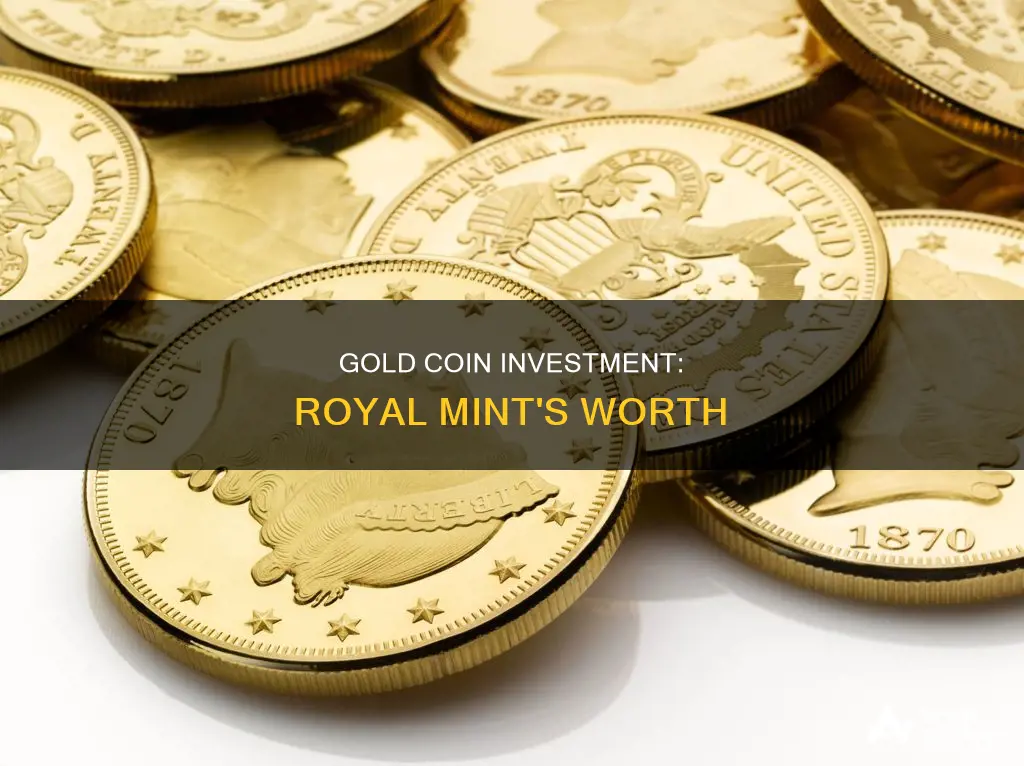
Gold has long been considered a 'safe haven' investment, and the Royal Mint has made it even more accessible with its DigiGold platform, which allows investors to buy fractions of gold, silver, and platinum stored in its vaults. The Mint has seen a 430% increase in millennial investors, who are taking advantage of the precious metal's reputation for withstanding market shocks. But is investing in gold risk-free?
Gold has been prized for thousands of years, and its value does not rely on the promise to pay like banknotes or share certificates. It is portable, highly transferable, and the original global currency. Its pricing is transparent, and it can be sold back into the market with confidence.
However, gold does not produce income in the form of interest, dividends, or rental income. It may also be subject to storage and insurance costs. While gold is exempt from VAT and Capital Gains Tax (CGT), it is not exempt from inheritance tax.
So, are Royal Mint gold coins a good investment? It depends on your goals. If you are looking for a safe, reliable store of value, bullion may be the best option. But if you are fascinated by rare and beautiful pieces, then collectible coins could be a worthy asset, treated more as a hobby than a pure investment.
What You'll Learn

Gold as a safe haven investment
Gold has traditionally been seen as a safe haven investment, able to withstand market shocks like no other investment. Its value has a long history of rising in times of economic uncertainty. However, that doesn't mean it's risk-free.
Gold is one of the world's oldest forms of investment, and its value lies in the precious metal itself. Gold has been prized and treasured for thousands of years, and people have bought gold objects and jewellery for centuries. Money has also been made from gold in the form of coins.
Gold is portable, particularly in the form of bullion coins, which has made it popular over the centuries with those who like to keep their wealth close at hand. It is also highly transferable, with no need for PIN codes or form-filling.
Gold is the original global currency. It has value anywhere in the world and can be exchanged among people from different countries and societies with minimum formality and no foreign currency costs or transaction fees.
Gold bars and coins are produced to specified weights and a specified quality, so buyers can purchase with confidence. The pricing of gold is transparent, with prices published daily in newspapers and on websites. There is also a competitive market in both the sale and purchase of gold.
Gold is often described as a 'safe haven' investment in times of volatility. The price of gold, which is valued internationally in US dollars, soared by around 450% between 2000 and 2011, rising from £168 ($273) an ounce to £921 ($1,500). It hit record highs in September 2011, almost cracking the $2,000-an-ounce mark and hitting a peak of $1,920.
Gold reached a peak in 2012 and has dropped since, and the price can be unpredictable and subject to big swings depending on economic sentiment, which poses a risk for investors. It dropped below $1,300 in the middle of 2021, and now sits around $1,200.
As with any investment, buying bullion is a gamble. Investors traditionally turn to gold as a haven in times of economic crisis, and its value often falls when the economy improves. To get the best out of gold, you need to time the market and try to get in at the bottom rather than the peak. This is hard to do as there are no stringent fundamentals behind gold that can help predict where the price is going. If you invest at the wrong time, you could make a big loss.
Gold is a non-income-producing asset, and the price is dictated by supply and demand, which makes it riskier than people may think. It doesn't produce interest, dividends or rental income; you'll only see a profit when you sell it.
However, gold is generally considered a reliable hedge against inflation, and its value has a long history of rising in times of economic uncertainty. Returns on gold have averaged 7.78% since 1972, similar to equities and outperforming bonds.
The World Gold Council suggests putting around 2-10% of a portfolio into a safe-haven investment such as gold.
The Future of Bitcoin Mining: Investing in Companies
You may want to see also

The Royal Mint's gold coins vs. other gold coins
The Royal Mint's gold coins are manufactured by one of the world's most historical mints, with a rich history that dates back to 886 AD. The mint's longevity and reputation for producing high-quality coins have made its gold offerings highly sought-after by collectors and investors alike.
The Royal Mint offers a range of gold coins, including the Britannia Coin, the Sovereign Coin, and the Queen's Beasts Coin. These coins are known for their intricate designs, high gold purity standards, and eligibility for investment schemes like Gold IRA. The mint also provides secure storage options for customers who wish to keep their gold coins in a protected environment.
When compared to other gold coins, The Royal Mint's offerings stand out due to their combination of craftsmanship, historical significance, and investment potential. The mint's gold coins are often sought-after by collectors, driving up their value beyond the gold content alone. Additionally, certain coins, such as the Britannia, Sovereign, and Lunar Bullion coins, are exempt from UK Capital Gains Tax for UK residents as they are legal tender.
However, it is important to note that gold coins from The Royal Mint may come with a higher premium compared to other options. This premium covers the costs associated with making and distributing the coins. For example, a one-troy-ounce coin like the Britannia typically includes a premium of about 4% above the spot price.
Other gold coins available in the market include the American Eagle, Chinese Panda, American Buffalo, Canadian Maple Leaf, Chinese Gold Panda, and Australian Gold Nugget. These coins may offer a cheaper premium over the spot price, making them more attractive to investors purely focused on tracking the gold price.
In summary, The Royal Mint's gold coins offer a combination of historical significance, intricate designs, and high gold purity standards. Their reputation and collectability drive up their value, making them a desirable option for both collectors and investors. However, the higher premium associated with these coins may be a consideration for investors solely focused on gold price tracking.
Legit Bitcoin Investment Pools: How to Get Started
You may want to see also

The Royal Mint's gold coins vs. other gold investments
Gold is often described as a safe haven investment in times of economic volatility. The Royal Mint, the UK's official mint, offers investors and collectors the opportunity to buy, trade, and store bullion coins.
The Royal Mint's bullion platform offers a single gold coin, such as the 22-carat George & Dragon 2014 Sovereign, for around £199. The Mint also offers the 1oz Britannia Gold Bullion or Lunar Gold coin for around £807. These coins are VAT-free for UK residents and exempt from Capital Gains Tax for UK residents as they are legal tender.
The Royal Mint's gold coins are a good investment option due to their widespread popularity, meticulous quality, and well-established secondary market. The Sovereign, for example, has a legacy of more than 500 years and is often regarded as the chief coin of the world. Its recognisable design and trusted status make it highly collectible, contributing to its liquidity. Additionally, the variety in size and cost of The Sovereign range provides investors with greater diversity in budgeting and the option to purchase gold coins regularly.
However, it is important to note that investing in gold coins, in general, has its drawbacks. Gold is a non-income-producing asset, and its price is dictated by supply and demand, making it riskier than other investments. The price of gold can be unpredictable and subject to significant swings, posing a risk for investors.
When compared to other gold investment options, The Royal Mint's bullion platform may be considered pricey, with an annual charge of 1.2%. Alternative platforms, such as BullionVault and BullionByPost, offer lower fees and access to bullion bars rather than just coins. Additionally, investors may find better value in buying shares in gold mining companies, using funds or exchange-traded commodities, or investing in gold exchange-traded funds, which provide similar exposure to gold at a lower cost.
In conclusion, while The Royal Mint's gold coins have their advantages, investors should carefully consider their investment goals and conduct thorough research before making a decision.
Bitcoin's Investment Potential: Why It's Worth Your Money
You may want to see also

The Royal Mint's gold coins as a pension investment
Gold has been a prized and treasured investment for thousands of years. The Royal Mint's gold coins are a good option for pension investment due to their long history, global recognition, and the fact that they are exempt from certain taxes.
Long History and Global Recognition
The Royal Mint's gold Sovereign bullion coin has an extraordinary history spanning more than 500 years. It is regarded as a flagship coin for the Royal Mint and is popular with investors all around the globe. The Sovereign is recognised for its meticulous quality and is highly collectible, featuring Benedetto Pistrucci's iconic 19th-century interpretation of St George and the dragon.
Exempt from Certain Taxes
The Sovereign bullion coin is VAT-exempt and, unlike other investments such as antiques, shares, or second homes, it is also exempt from Capital Gains Tax (CGT) for UK residents due to its classification as legal tender. This makes it a tax-efficient option for UK-based investors.
Portable and Transferable
Gold coins from the Royal Mint, particularly bullion coins, offer the advantage of portability. They have been valued over the centuries by those who like to keep their wealth close at hand. Gold is also highly transferable, requiring no PIN codes or paperwork for transactions.
Competitive Market and Transparent Pricing
There is a competitive market for gold coins, giving investors the flexibility to shop around for the best prices. The pricing of gold is transparent, with daily updates published in newspapers and on websites. This transparency helps investors make informed decisions and sell their gold with confidence.
Diversification and Safe Haven
Gold is often described as a 'safe haven' investment during volatile economic periods. It has a long history of rising in times of economic uncertainty. The World Gold Council recommends putting around 2-10% of a portfolio into safe-haven investments like gold to diversify one's pension investments.
Combination of Historical and Cost-Effective Coins
For those building a gold coin collection for their pension, a combination of historical gold coins and cost-effective secondary market coins can be considered. While historical coins may offer higher premiums over time, recent variants with smaller premiums can provide more predictable returns.
In conclusion, The Royal Mint's gold coins are a good option for pension investment due to their long history, global recognition, tax advantages, portability, transparent pricing, and their role as a safe-haven investment.
A Beginner's Guide to Bitcoin Investing in India
You may want to see also

The Royal Mint's gold coins as a collectible
The Royal Mint's gold coins are highly sought-after by collectors and investors alike. With a history of manufacturing coins since 886 AD, the British Royal Mint is one of the most historical mints in the world. Its gold coins are known for their exquisite craftsmanship and high gold purity standards, making them highly desirable for collectors.
The Sovereign bullion coin, for instance, is a flagship coin for The Royal Mint, recognised and trusted worldwide. With a legacy spanning over 500 years, the Sovereign coin features Benedetto Pistrucci's iconic 19th-century interpretation of St George and the dragon on its reverse. This recognisable design, along with its meticulous quality, makes the Sovereign coin highly collectible.
The Royal Mint also offers a range of bullion coins, including the Sovereign, Double-Sovereign, Half-Sovereign, and Quarter-Sovereign. These coins are available in individual capsules and tubes, providing investors with a greater choice for their portfolios. Additionally, the Royal Mint releases rare and historic Sovereign coins, adding interest to bullion coin collections.
Another popular collectible is the Britannia bullion coin, which contains 99.99% pure gold. In 2023, the Royal Mint introduced its first Britannia bullion coin bearing the portrait of King Charles III. This coin is enhanced with security features and is highly sought-after by collectors.
The Queen's Beasts Gold Coin is another example of British gold coin design and quality bullion. The intricate design features a roaring lion standing over a shield, surrounded by the words "Lion of England," "1 oz Fine Gold," "999.9," and the year of the strike. The obverse of the coin displays the profile of the Queen, along with the 100-pound currency designation.
The historical significance, exceptional craftsmanship, and high gold purity standards of the Royal Mint's gold coins make them highly desirable for collectors. The collectability of these coins is further enhanced by their limited editions, historical milestones, and aesthetic appeal. For collectors, acquiring these coins is not just an investment but also a passionate hobby.
Coinbase: Stocks and Crypto Investment Opportunities
You may want to see also
Frequently asked questions
Gold has been prized and treasured for thousands of years. It is a dependable store of value, particularly in times of economic uncertainty, and is considered a safe haven asset. Gold is also highly portable and transferable, and its value is not reliant on someone else's promise to pay.
Gold can be volatile and unpredictable, and there are fewer ways to diversify gold holdings compared to other assets. Gold also doesn't produce any income, and there may be costs associated with storing and insuring it.
You can invest in physical gold, such as bullion bars and coins, or in digital gold, such as virtual slices of a gold bar. Popular gold coins include The Sovereign, Britannia, Eagle, Maple Leaf, and Krugerrand.
In the UK, certain gold coins, such as The Sovereign and Britannia, are exempt from Capital Gains Tax (CGT) as they are legal tender. However, gold is not exempt from inheritance tax.







